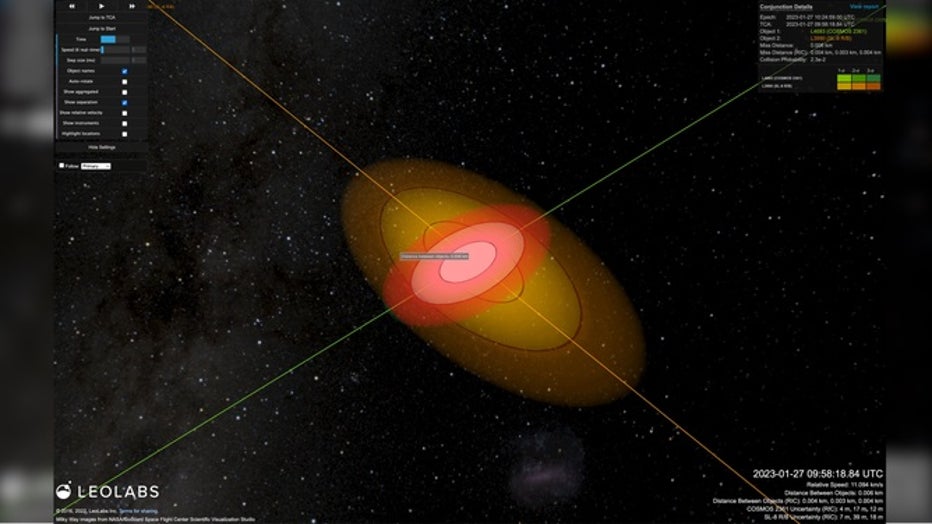Satellite, rocket body miss collision by only 20 feet in what could have been ‘worst-case scenario’

Watch simulation of space debris orbiting the Earth
The following graphics are computer generated images of objects in low-Earth orbit that are currently being tracked. The orbital debris dots are scaled according to the image size of the graphic to optimize their visibility and are not scaled to Earth. (Courtesy: NASA ODPO)
A "worst-case scenario" was thwarted on Friday when two large pieces of space debris narrowly missed each other, according to LeoLabs.
LeoLabs said the debris included the defunct satellite Cosmos 2361 and an SL-8 rocket body, which are two of countless pieces of space debris currently in low-Earth orbit.
WHY A SPACECRAFT CLAW WAS BUILT TO CLEAN UP SPACE JUNK
According to NASA, objects in low-Earth orbit (or LEO) involve objects orbiting our planet at an altitude of 1,200 miles (2,000 km) or less.
On Friday, Cosmos 2381 and the SL-8 rocket body nearly collided at an altitude of about 611 miles (984 km).

An image showing how two large, defunct objects in LEO narrowly missed each other on January 27, 2023. Each line represents the paths of an SL-8 rocket body (16511) and a Cosmos 2361 (25590) satellite. (LeoLabs / https://leolabs.space / FOX Weather)
LeoLabs determined that the two pieces of space debris missed each other by about 20 feet (6 meters), with an error margin of only a few tens of meters.
SPACE DEBRIS CAUSES SPACE STATION TO MOVE OUT OF WAY, DELAYS NASA ASTRONAUT SPACEWALK
"We've identified this kind of collision — between two massive derelict objects — as a ‘worst-case scenario’ because it's largely out of our control and would likely result in a ripple effect of dangerous collisional encounters," LeoLabs said in a tweet.
They said that had the Cosmos 2381 and SL-8 rocket body smashed into each other, the collision would have resulted in thousands of new debris fragments that would remain for decades.

NASA's DART spacecraft slams into target asteroid in defense test
The galactic slam occurred at a harmless asteroid 7 million miles (9.6 million kilometers) away, with the spacecraft named DART plowing into the space rock at 14,000 mph (22,500 kph). Scientists expected the impact to carve out a crater, hurl streams of rocks and dirt into space and, most importantly, alter the asteroid?s orbit.
This near-collision is significant because it illustrates how much space debris is floating around in low-Earth orbit.
According to LeoLabs, a layer of the LEO that’s only about 62 miles thick contains an estimated 160 SL-8 rocket bodies, along with their 160 payloads, that were deployed over 20 years ago.
WHY SPACE TRASH WILL CONTINUE TO BE A PROBLEM IN LOW-EARTH ORBIT
This "bad neighborhood" in the LEO, said LeoLabs, is located between altitudes of 950 and 1050 km and continues to be a hotspot for debris collisions.

Astronaut Randy Bresnik participates in a spacewalk outside of the International Space Station. The ISS lies within the low-Earth orbit. (NASA)
These collisions and near-collisions in LEO remain top of mind for many.
Because in addition to being populated with defunct space debris, the LEO region is also considered an area near enough to Earth for convenient transportation, communication, observation and resupply, according to NASA.
LOOK OUT FOR THESE ASTRONOMICAL EVENTS IN FEBRUARY
In fact, LEO is where the International Space Station currently orbits and where many proposed future platforms will be located.

